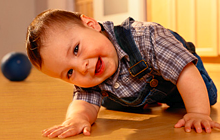Activities
Although there are a few more activity pictures of men interacting with children overall, activities are evenly dispersed (see Table 5). GG follows this trend presenting equal numbers of men and women performing activities with children. This similarity in numbers suggests a symmetry between men and women regarding these parenting behaviors; it seems like these behaviors aren't gendered. At first GG appears to follow this trend. Unfortunately, the symmetry breaks down when one examines the types of activities being performed by men and women on GG's website. When women are featured playing with children on GG's site the toys and activities are different. One toy women with children use is a yellow block/box, one is a stuffed animal, and one is a plastic object shaped like a hand. Women with children are pictured rough-housing, giving piggy-back rides, and observing a child climbing. These toys and activities are not unusual and can be read as showing how mothers are multidimensional when being active with their children. They can be said to be teaching motor skills and building through the use of toys; being aggressive strong players in roughhousing and giving piggyback rides; and they are concerned for their children's safety. GG and other ART company websites picturing activities feature mothers engaging in a variety of activities with children.
Similarly, men in GG and other ART company websites are pictured performing a variety of activities. However, when one examines more closely at the activities GG' displays for men with children one can see a gendered instruction about masculinity occurring. Men performing activities with children have more significant props that help create a narrative associated with masculinity. Men as fathers teach children about technology, literacy, locomotion, and who "brings home the bacon" or supplies food (see Figure 9). While there are other pictures of men performing activities as well (e.g. rough-housing, another picture encouraging walking, tickling, and a picture with a yellow box/block), these pictures are significant in characterizing what it means to be a father.
Figure 9: GG and activity

teaching/playing
communication
technology

teaching/playing
literacy

teaching/playing
locomotion

feeding child
acting as provider
and enabling eating
Though ART company websites present nearly equal numbers of men and women with children performing activities, the differences become even more meaningful and compelling when compared to another type of activity—snuggling and nuzzling. In other words, since men are rarely shown snuggling and nuzzling with children, the symmetry in regards to these representations informs audiences that this is the way men or fathers interact with children; men may engage in activities with children, like women and mothers, but do not snuggle and nuzzle. Pictures of men with children performing activities, moreover, are not idealized like the pictures of men snuggling and nuzzling. When men are with children, the real pictures show men performing activities such as teaching, playing, and feeding. The implicit effect of the contrast between fathers snuggling and nuzzling in black and white pictures and the color pictures of fathers performing activities in non-sperm donation company sites are instructive to audiences about the behaviors of mothers and fathers.
Instructions about parenthood also occur in the absence of men from pictures with children. One way to put this in perspective is to consider how out of the eighty-two total pictures found of men alone or women alone with children (i.e. one woman with a child or one man with a child) regardless of behavior only twenty-seven (33%) are of men are pictured alone with children5. Because they are not pictured as much as women with children, audiences are instructed about fatherhood. The absence of fathers can be read as normal, it is as if fathers are away at work—exercising their minds. Because the emphasis on fatherhood is on activity between fathers and children, this becomes men’s place in parenthood. More intimate pictures between women and children suggest that children are women’s realities and this is normal. Intimate pictures between women and children, furthermore, can even be considered pictures of fusion; women and children are one. Men may also be one with children, but this fusion isn’t real; these pictures, as discussed in Snug/Nuzzling, can be presented as unusual, as art or ideal.
Interestingly, GG also makes an important claim regarding gender and children and the sorts of activities they make take part in. While it is difficult to ascertain a child's gender in most of the activity pictures, it is not difficult to ascertain gender role performances in the pictures of children on GG's homepage (see Figure 10). These five pictures act as a slideshow and are gender stratified. The girls are sun bathing and crawling on a cloud or bed-like object. In more words, the girls are sexualized. The boys, on the other hand, are active, playing with technology (with balls) and soaring (being thrown). Boys are active learners and for a boy, the sky is the limit. The active/passive gender dichotomy is reinforced to audiences and instructs them about appropriate gender behavior.
Figure 10: GG's girls, boys, and gender roles

sunbathing

crawling on bed
(read as girl—has earrings)

playing with ball

played with ball

playing and soaring
Nevertheless, the focus on snuggling and nuzzling by women with children contributes to the patriarchal mind/body dualism. Laura Shanner (2000) explains:
If women are their bodies, then women are material things or objects that may be used for sexual or reproductive purposes. A woman who fails to reproduce is therefore herself a failure that needs to be fixed or replaced. (p. 157)
A mother's connection to the body, rather than to mind (work outside the home) is supported in these websites. Stereotypical fatherhood is also supported. He works. Then he comes home and plays or teaches or feeds. He is fun and knowledgeable, but not connected to children intimately. He prepares children for their future. If the child came from a sperm donor, then he enables potential. She intuits. She supports. She comforts. When coupled with the instructions in Snug/Nuzzling, the commonplace instruction or rule of thumb for being a parent is that men are fathers who facilitate potential and provide sustenance, while women are mothers who take part in all dimensions of child development—though they are especially responsible for nurturing.
5 There are a few websites that represent men alone and women alone with children in equal numbers or greater numbers of men alone with children. My main argument here, however, is that, in general, women are pictured with children in greater numbers. A web searcher searching websites for ART services is more likely to stumble/click upon pictures of women alone with children and women with children in general when web searching.
Table 5: Activities occurring between women with children and men with children*
Return to text
| Sperm | Egg | Surrogacy | Egg and Surrogacy | Sperm and Egg (NAC) | Sperm, Egg, and Surrogacy (GG) | Total No. | |
|---|---|---|---|---|---|---|---|
| No. sites with activity | 4/8 | 3/6 | 1/2 | 6/10 | 0/1 | 1/1 | 15/28 |
| Women activity | 4 | 2 | 2 | 8 | 0 | 7* | 23 (45.1) |
| Men activity | 8 | 1 | 3 | 9 | 0 | 7 | 28 (54.9) |
*GG does have two pictures where pregnant women are participating in a unique activity where children are touching their bellies. These pictures, however, were interpreted as different type of intimacy picture or snuggling and nuzzling rather than both snuggling and nuzzling and activity. These two pictures were not counted as activity pictures in this study.

